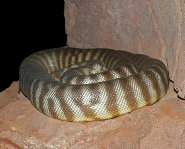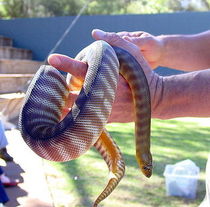Woma
Woma - a Snake With a Neck
 There are 2,900 species of snakes in the world, from the tiny thread snake to the mighty anaconda. They are revered and feared, pressed into service as companion animals and hunted for their meat and skin. Some, like the Woma snake, are endangered.
There are 2,900 species of snakes in the world, from the tiny thread snake to the mighty anaconda. They are revered and feared, pressed into service as companion animals and hunted for their meat and skin. Some, like the Woma snake, are endangered.
The Woma (Aspidites ramsayi) is better known as the "Pit Python", but has a variety of other names as well. Depending on where they are found, they are known as Ramsey's python or sand python, and in areas where the Aboriginal people still live and hunt, they are called "jilajaku". Their habitat is the deserts of Western Australia.
There are several interesting features which makes the Woma unique. To begin with, though the average length of the Woma is 4.5 ft, or 1.5m, and their weight is approximately 5 kgs, or 11 lbs, they can range in size from mid-size to very large. The diversity of the Woma python's length and weight is based on the animal's age and diet. And diet depends on where they live and what is available. Some Womas live on small animals such as lizards and mice, but others live on larger mammals such as rats and other desert-dwelling rodents.
The other unique feature of this snake is its appearance. Unlike most snakes, the Woma python is a snake with a neck. The area just behind his head narrows enough to be quite noticeable, making it appear as if the snake has cervical vertebrae. It is a nocturnal animal, and it hunts in burrows in the desert dunes of Western Australia.
Finally, though this snake is a member of a species of snake called "constrictors" for the way they kill their prey, the Woma cannot actually wrap his body fully around the victim because they are in a burrow making it impossible for him to fully use his body. So, the snake pushes the victim against the side of the burrow, crushing it.
The Woma python is a favorite of Australians searching for their first pet snake because of its docile nature and simple needs. Though snake-keeping as pets is becoming more difficult as worldwide regulators are requiring special licenses for those who are hunting, transporting and offering them as pets. The Aboriginal people who live in Australia's outback still hunt them for their meat and skin, which is distinct and attractive. It's boldly colored bands and the appearance of a cervical area make it a favorite of herpetologists everywhere.
Picture of the Woma by Peter Halasz at Sydney Wildlife World, licensed under the Creative Commons Attribution-Share Alike 2.5 Generic license
The Woma is classified as Endangered (EN), considered to be facing a very high risk of extinction in the wild.
Common names
Aspidites ramsayi in Italian - Italiano
Krajta hnědohlavá in Czech - česky
Pitón de ramsay in Spanish - español
Python de ramsay in French - français
Ramsay's python in English - English
Woma in English - English
Woma in French - français
Woma Python in English - English
Woma-Python in German - Deutsch

Original source: Wikimedia Commons
Permission: Some rights reserved
